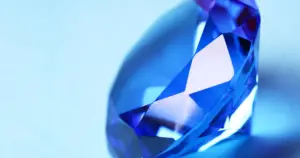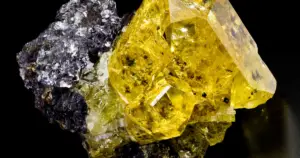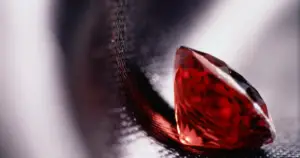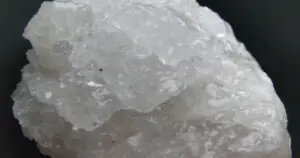Can Purple Labradorite Go in Water?
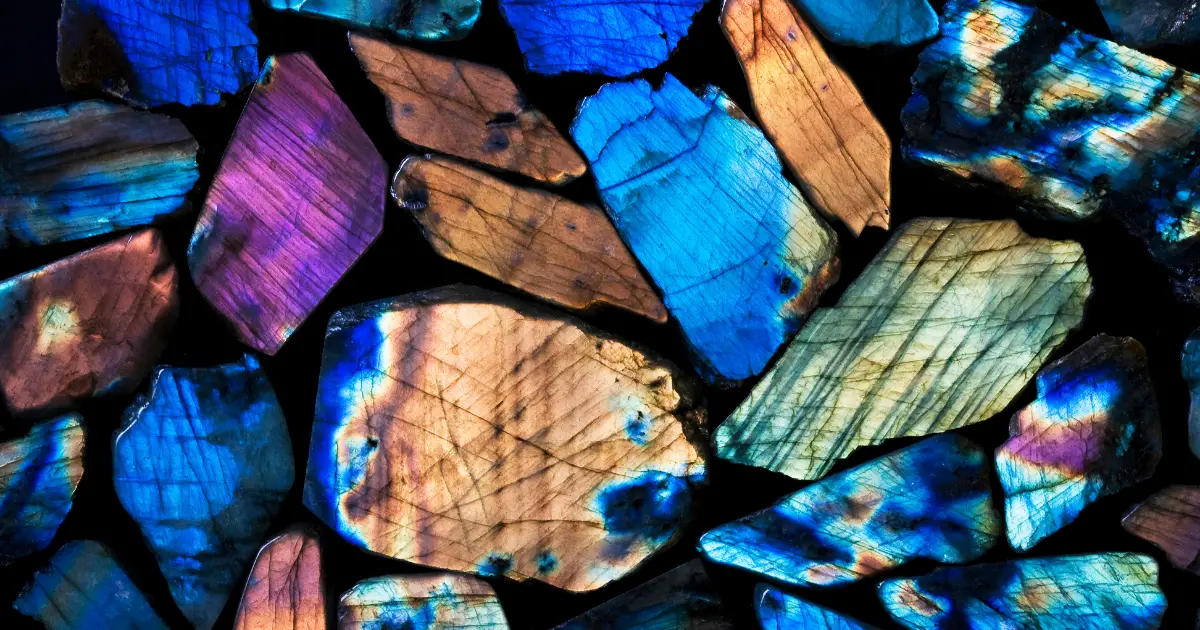
One of the most lovely gemstones in our Crystal world is the Purple Labradorite Stone. Usually, Labradorite is found in blue, green, or yellow, so if you very own this valuable stone, you can consider yourself lucky, as they’re difficult to find, and very few people have them.
Let’s explore Can Purple Labradorite Go in Water? , If yes, then how does it behave?
Also Read: Purple Labradorite Meaning: Healing Properties, Benefits and Uses
Table of Contents
What Is a Purple Labradorite Stone?
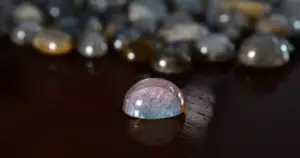
Labradorite is a semi-treasured stone made of Plagioclase and Feldspar that normally flashes colorfully when exposed to light. This phenomenon is referred to as adularescence.
The stone is referred to as the “stone of magic” because it is an idea if you want to wake up spiritual abilities in individuals.
To know about the Astrological benefits of purple Labradorite read here.
Purple Labradorite Physical Properties
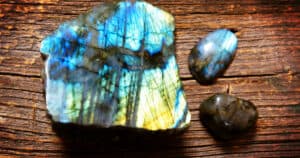
Labradorite comprises 30-50% sodium feldspar and 50-70% calcium feldspar molecules and is a plagioclase feldspar. The introduced potassium feldspar molecules, barium lines, and strontium molecules inner also contribute to its light-emitting homes.
It ranks between 6 and 6.5 on the Mohs hardness scale and has a particular gravity of 2.56 to 2.76. The crystals of Labradorite are usually plate-shaped and feature a glassy look. Labradorite crystals can reach lengths of two meters.
Read here the various Benefits of Purple Labradorite.
Can Purple Labradorite go in Water?
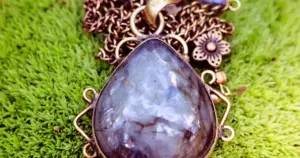
Getting your Purple labradorite crystal in contact with water could make you puzzled and worried because you might imagine that water may want to damage your beloved labradorite gem.
The solution is yes; Purple Labradorite can get moist. However, it doesn’t mean you must go away your crystal for a prolonged time submerged in water. Long immersion in water can severely damage your Labradorite by making it look dull and developing a hard touch.
Yes, Labradorite can get water; however, with conditions. You can get your Labradorite stone wet. You are allowed to clean the stone’s surface for a brief amount of time (a little while) underneath running water.
So, getting it moist infrequently and at some point in a constrained amount of time is considered innocent. Unlike Halite and Selenite crystals that fast show indicators of dissolution when they get in touch with water.
One thing to remember is to usually pat dry with smooth fabric on each corner/surface of the stone before storing it returned along with your crystals collection.
Can purple Labradorite go in Water: What Happens to it when it gets wet?
Here are three essential factors to recall while getting Purple Labradorite in contact with water. Prolonged water immersion is taken into consideration as unfavorable for Labradorite.
1. Mineral coating
Most labradorite stones are lined with a fine layer of polish that performs a primary protective role to preserve you from getting cut using the problematic edges of the raw natural state of the stone so that you can take care of your labradorite crystal well.
So, after you soak the stone in water for lengthy hours, the polish layer will step by step come off, which will go away the stone is immediately exposed to water.
As a result, when exposed to water for extremely long periods to remove the labradorite stone from its performance, the outer layers of the rocks will be severely damaged, and the lack of coating will give it a rough and unpleasant feel.
2. Labradorescence
Labradorescence is the signature sparkling iridescence exhibited through labradorite crystals.
It has to be disappointing to lose the labradorescence end of your Labradorite stone.
To keep away from that, steer clear of submerging your crystal in water for a prolonged period. This is because long water immersion will sooner or later adjust this specific look and transform it into a gloomy, shineless-looking crystal.
3. Mineral composition
Feldspar mineral Labradorite is what it’s called. Sodium (Na) is one of the most common mineral components in feldspars, and it can be very reactive with water.
The Sodium thing and its reaction to water over the years will subsequently lessen the general mineral power of Labradorite which transforms it into a fragile stone that can crack and get damaged very effortlessly.
Another key component to add is that submerging Labradorite for plenty and plenty of hours in water frequently and repetitively will finally create microscopic fissures so one can broaden over the years into visible cracks inside the surface of the Labradorite stone.
Can Purple Labradorite go in Water: Is it water friendly?
Yes, Purple Labradorite can get wet. However, as with most crystals, gemstones, stones, and minerals, you should use caution, as mentioned above, while setting Labradorite in water.
Can Purple Labradorite go in Water: Does it lose its Color?
Purple Labradorite is mildly sensitive to water, and excessive exposure can destroy its shine and luster.
Can Purple Labradorite go in Water: Can it go in Saltwater?
Although you may hear people suggesting that saltwater baths are a great manner to recharge Labradorite’s energetic properties, placing any stone, gem, crystal, or mineral in Saltwater ultimately deteriorates it quicker than ordinary water. We don’t recommend soaking it in salty water, which might speed up the above events. As a result, Purple Labradorite should not be placed in Saltwater.
If you feel that salt is necessary for recharging your Labradorite, it is safer to place it on a salt bed rather than immersing it in a full-on saltwater bath. This way, you don’t have to worry about salt getting stuck in any cracks on your Labradorite’s surface and corrupting it.
How do you take care of Labradorite stone?
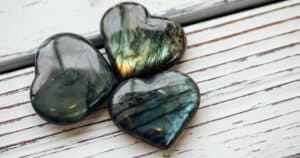
Five Cleansing alternatives to protect your Labradorite crystal We can conclude that Labradorite can get moist but in a precautious manner.
Occasionally, your stone can contact water, but only for a short period (if you accidentally get your crystal moist, or you need to scrub it immediately underwater for a short while to dispose of dust from its surface, which can’t be eliminated with a dry fabric).
Nevertheless, if you wish to cleanse your labradorite stone, water is not the only way to purify it from absorbed negative energies. Luckily, more secure and equally powerful cleaning alternatives exist that are completely sufficient for purifying Labradorite.
1. Earth
Placing your crystals at once on the Earth is this kind of deep cleansing technique that absorbs all of the attached bad vibrations. You can position your Labradorite crystal at once in the world, in your garden, or your plants’ pot and depart it there the complete nighttime or for 10 to twelve hours. After that, gently remove dust, dirt, or debris with a dry material.
2. Moonlight
Moonlight is the best natural source of cleaning that can bring back to the crystals their original and potent restoration properties. You can place your Labradorite on your windowsill (ensure to locate it in a safe region to avoid any breakage or harm) and permit it to soak and absorb the natural light of the stars or the moon for the whole night.
3. Rice
This may additionally appear as a unique cleaning technique. However, it’s miles pretty effective! The rice bed method releases the acquired bad, poisonous, and unwanted energies stored in crystals. Just fill a box with dry rice, bury your Labradorite, and depart your crystal for 24 hours.
Removing and not using the rice at once after cleaning your crystal is essential because it will become the host of all the absorbed terrible energies released via Labradorite.
4. Sage
Sage is the sort of terrific cleansing tool on the way to purify Labradorite from all the stored terrible energies.
It is this kind of healing and harmless device that is able not best to unfasten the stone from the absorbed vibrations; however, it will simultaneously cleanse your aura and lift your spirit.
The smoke generated by the sage will charge your crystals with the energy of purity, positivity, and harmony. Visualize that the terrible energies stored through your labradorite crystal evaporate with the smoke as it arises and dissolves into the air.
Let the smoke surround Labradorite for approximately 30 seconds. Don’t forget that before starting the sage cleansing ritual, open your windows to allow the pass of the smoke generated by using the sage.
5. Big crystals cluster
This cleaning method is just perfect for small tumbled labradorite stones. Larger crystals radiate powerful recovery and clarifying energies that can free smaller crystals from terrible and unharmonious vibrations.
Big crystal clusters, for example, Quartz Geode, Amethyst geode, Selenite geode, or Calcite geode, are effective devices to purify smaller crystals from the saved terrible energies. You can region small Labradorite crystals in those clusters and depart them for 24 hours.
So, we can use larger crystals as an opportunity-cleansing tool. They have the special capacity to radiate potent recovery and purifying energies that liberate smaller crystals from destructive and discordant vibrations.
Suggested Reading: Labradorite Meaning: Healing Properties, Benefits and Uses
Summary
Labradorite is a unique mineral that displays marvelous iridescent. Labradorite can get moist quickly, and rare exposure to water will no longer harm your stone.
Purple Labradorite is a sort of Labradorite, a mineral with sturdy metaphysical houses. The purple color within the gemstone is usually attributed to copper ions inside the crystal structure and the presence of iron.
The prominent colorations of this stone exhibit a kind radiance, so taking care of this gem is a must to protect this crystal’s authentic and natural shine.
Still, immersing Labradorite in water for a long time can certainly make serious and irrevisable damage by making your crystal lose its unique radiance and altering the smooth touch of your stone.
